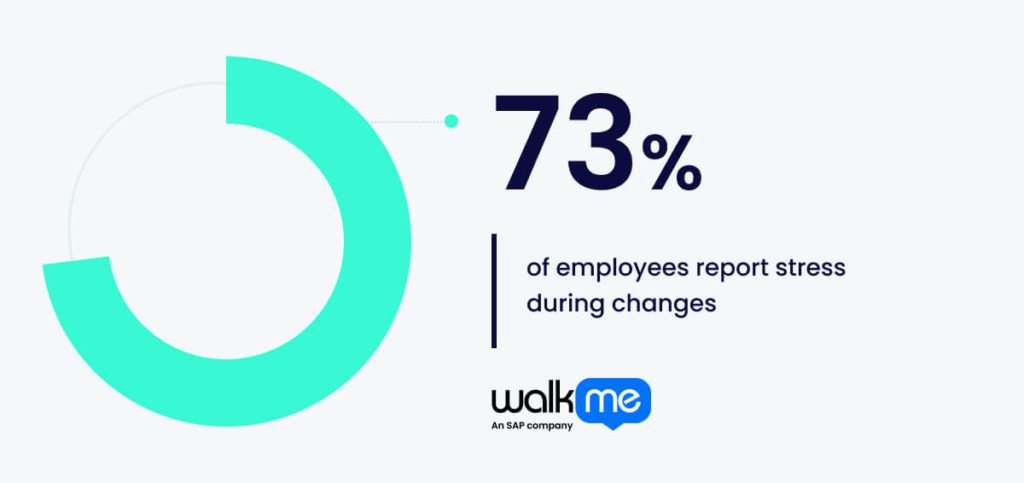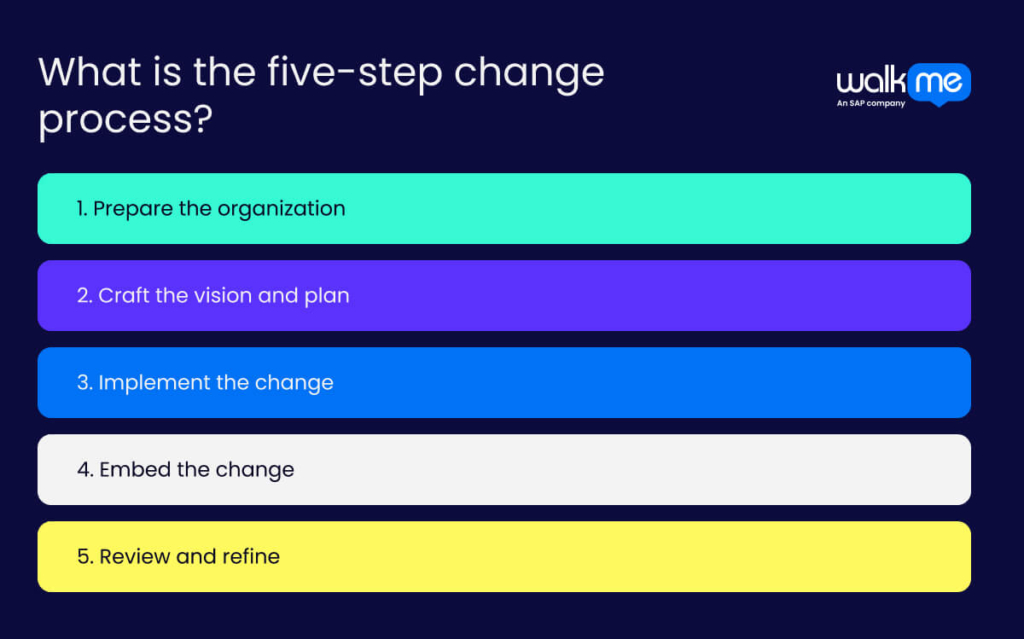The change process is a systematic approach to managing organizational transitions, crucial for improving performance and adapting to new circumstances.
Effective change management is vital. 73% of employees report stress during changes, which results in a 5% performance dip.

This is especially true today, where digital innovation and disruption demand adaptability.
Without proper change management, businesses risk obsolescence and missed opportunities. The process involves identifying and implementing key shifts, including adopting new technologies, revamping operational methods, or altering organizational culture.
This article will delve into the change process, emphasizing its importance for businesses focusing on digital transformation. We’ll also provide a five-step implementation guide for embracing change effectively.
What is the change process?
The change process refers to an organization’s planned sequence of actions to transition from its existing operations to a more desired or optimal state.
This methodology is designed to enhance performance metrics, streamline efficiency, and enable adaptation to evolving circumstances.
Pivotal to this process is the identification of areas necessitating change. This could include technological upgrades, procedural modifications, or organizational cultural changes.
Following identification, these changes are prioritized based on their potential impact and feasibility, ensuring the most beneficial alterations are implemented first.
Implementation of these changes is guided by strategic planning and project management principles. It often involves stakeholder engagement, resource allocation, risk assessment, and continuous monitoring to ensure the change objectives are met effectively and efficiently.
The change process also includes mechanisms for feedback and learning. Post-implementation reviews are conducted to assess the outcomes of the change initiatives, learn from the experience, and make necessary adjustments for future change processes.
Why is the change process important?
The change process is vital for business resilience, enabling companies to navigate challenges ranging from cybersecurity threats to sudden market shifts.
Only 1/3 of major change initiatives fully meet the goals set by the organization. This statistic shows the complexity of implementing change and the importance of a well-structured change management process.
It nurtures a culture of ongoing learning and growth, crucial today when customer demands and technology are in constant flux. This process is essential for implementing digital transformation strategies effectively, ensuring that changes permeate the organization’s structure and culture.
By doing so, businesses can fully harness digital technologies to enhance performance, boost efficiency, and improve customer engagement.
What is the five-step change process?

The five-step change process is a systematic approach to implementing organizational change effectively.
This model provides a structured framework for leaders and managers to guide their organizations through transition and transformation.
Let’s take a closer look:
Prepare the organization
Change begins with preparation. This step involves assessing the current situation and building a case for change. Leaders must identify the need for change, define clear objectives, and develop a compelling vision for the future.
They should gather data, analyze potential impacts, and secure support from key stakeholders. Creating a strong guiding coalition is crucial at this stage. Communication planning starts here, focusing on conveying the urgency and importance of the change to all levels of the organization.
Craft the vision and plan
With preparation complete, the next step is to craft a detailed vision and plan. This involves translating the high-level change concept into specific, actionable strategies. Leaders should define measurable goals, identify potential obstacles, and develop strategies to overcome them.
The plan should include timelines, resource allocation, and role assignments. It’s crucial to consider the organizational culture and how it might impact the change process. Involving representatives from various departments can ensure a comprehensive and realistic plan.
Implement the change
Implementation is where the plan comes to life. This step involves executing the strategies developed in the previous phase. It is crucial to manage the transition well and provide support and resources to employees as they adapt to new processes or systems.
Regular check-ins and progress reviews help keep the change on track. Leaders should be visible and actively involved, demonstrating their commitment to the change. Flexibility is key during this phase, as unforeseen challenges may require adjustments to the plan.
Embed the change
Once the change is implemented, the focus shifts to embedding it into the organization’s culture and operations. This step involves reinforcing new behaviors, processes, and systems to ensure they become the new norm. Leaders should align organizational structures, policies, and performance management systems with the change.
Providing ongoing training and support is crucial. Addressing any lingering resistance and continuously communicating the benefits of the change are also important. Creating feedback mechanisms can help identify areas needing further attention.
Review and refine
The final step involves reviewing the change process and its outcomes and refining it as necessary. This includes assessing whether the change has met its objectives, identifying lessons learned, and determining any need for further adjustments.
Gathering feedback from various stakeholders provides valuable insights. Leaders should celebrate successes and acknowledge the efforts of those involved in the change. Establishing processes for continuous improvement ensures the organization remains adaptable to future changes.
How to implement the change process
The change process needs to be tailored to the organization’s specific needs.
Implementing an off-the-shelf solution is pointless. A tailored solution should fit the organization’s unique context and objectives.
Here are some steps to consider when rolling out a change process:
Identify the need for change
A shift in strategy becomes essential when an organization faces challenges in its current operations or market conditions.
This step thoroughly examines internal processes, performance data, and market trends. It’s about spotting gaps, addressing weaknesses, and capitalizing on opportunities.
The process needs to be data-driven, involving careful analysis of metrics and KPIs. The organization can remain competitive and relevant by identifying areas needing change.
Define the change
Defining the change is a pivotal step in the transformation process.
This involves detailing the scope, objectives, and potential impact of the proposed changes on various facets of the organization.
A clear definition helps set expectations, reduce uncertainty, and plan effectively. It establishes a clear path from the current state to the intended future state, creating a roadmap everyone can follow.
Develop a vision and strategy
Creating a compelling vision and robust strategy sets the pace for the change process.
The vision presents a picture of what the future will look like post-change, serving as both a guide and a source of motivation.
The strategy provides a detailed action plan outlining the steps to be taken, resources needed, and potential roadblocks. It serves as a blueprint for achieving the vision, aligning all efforts towards a common goal.
Communicate the change
Communication plays a crucial role in any change management process.
It involves keeping stakeholders informed about the reasons for change, its benefits, and how it will be implemented. Consistent, transparent communication can help dispel fears, build trust, and secure buy-in from all involved.
Through effective communication, organizations can promote understanding, alleviate concerns, and foster a culture of cooperation.
Implement the change
The implementation phase is where plans turn into action.
It could involve introducing new technologies, altering business processes, or restructuring teams. Effective project management is vital during this stage to ensure tasks are completed as planned and disruptions are minimized.
Regular checks and balances ensure the implementation stays on track and any deviations are promptly corrected.
Manage resistance
Resistance to change is a natural human response, often stemming from fear or discomfort.
The key to managing resistance lies in understanding its root causes and addressing them through empathy, support, and reassurance. Providing necessary training and resources can also help ease the transition.
Proactively dealing with resistance smoothens the change process and fosters a positive work environment.
Monitor and evaluate the change
Post-implementation, monitoring the progress, and evaluating the effectiveness of the change is crucial.
This involves assessing whether the change has met its objectives, tracking key performance indicators, and gathering feedback.
Regular reviews and evaluations help identify areas for improvement and provide insights for future change initiatives.
Consolidate and embed the change
The final step in the change process is integrating the change into the organization’s everyday operations and culture.
This involves reinforcing the change through ongoing training, communication, and recognition. It ensures the change’s sustainability and continued contribution to the organization’s success.
Making the change part of the organization’s DNA becomes a stepping stone to further growth and innovation.
What factors influence the change process?
The success of a change process greatly depends on its implementation.
Several factors can affect how smoothly and successfully a change is implemented, from organizational culture to resource availability.
Here are some key considerations:
Leadership Support
For success, leadership must be committed to and actively involved in the transformation process. Leaders must demonstrate a clear vision, provide resources and support, and be willing to take risks. By setting an example of change readiness, they can help create a culture that supports transformation initiatives.
Communication
A significant part of the change process is communication. Organizations must communicate the need for change, objectives, and expected outcomes to stakeholders. Regular updates must be provided throughout the process to keep everyone informed and on track. Effective communication fosters understanding and garners support for the proposed changes.
Resources
Having enough resources is essential for successfully implementing a change process. Organizations need to assess their capacity in human resources, technology, budgeting, and other areas before embarking on a transformation journey. Businesses can outsource specific tasks or hire experts to ensure completion within the required timeline.
Training
Organizations must provide training to employees at all levels to implement positive change. Training helps employees become familiar with the changes, understand their implications, and develop the skills needed to carry them out. It also ensures that everyone is equipped to use new systems, processes, and technologies efficiently during and after the process.
Feedback
Gathering feedback from stakeholders at various stages of a change process is essential for ensuring its effectiveness. Organizations should solicit input from all involved, including employees, customers, and other stakeholders. This helps identify areas where the process can be improved and ensure everyone’s needs are met. Analyzing this data can also present valuable insights for future initiatives.
Adaptability
Change processes involve continuous learning and improvement. Organizations must be prepared to adjust their strategies according to stakeholders’ changing needs to ensure the initiative’s long-term success. Recognizing, analyzing, and responding quickly and appropriately to external factors is key for organizations navigating a dynamic environment.
What comes after the change process?
Once a change process has been successfully implemented, businesses can anticipate a period of stabilization and potential growth.
The newly adopted practices, systems, or structures start to take root, gradually becoming the norm. During this phase, businesses often experience heightened efficiency and productivity as the adjustments made during the change process begin to show results.
Post-change, businesses must maintain a culture of learning and development. Even after successful implementation, organizations should stay open to further adjustments based on feedback and performance data. This ensures that the changes meet the organization’s learning curve goals and keep pace with any external shifts in the market or industry.
After the change process, businesses can evaluate their change management capabilities. Reflecting on what worked well and could be improved provides valuable insights for future change initiatives.
These insights can help refine the organization’s approach to change, making it more effective and less disruptive.
FAQs
The 5 C’s of change are:
- Concern
- Control
- Curiosity
- Confidence
- Commitment
These represent the emotional stages individuals typically experience during a change process, progressing from initial worry to full engagement and support.
The 7 R’s of change management are:
- Reason
- Results
- Route
- Roles
- Resources
- Risks
- Review
These elements form a comprehensive framework for planning and executing change initiatives, covering the rationale, goals, methods, responsibilities, support, potential issues, and evaluation of the change process.
The 5 E’s of change management are:
- Envision
- Engage
- Empower
- Execute
- Embed

